64 Cores of Rendering Madness: The AMD Threadripper Pro 3995WX Review
by Dr. Ian Cutress on February 9, 2021 9:00 AM EST- Posted in
- CPUs
- AMD
- Lenovo
- ThinkStation
- Threadripper Pro
- WRX80
- 3995WX
CPU Tests: Rendering
Rendering tests, compared to others, are often a little more simple to digest and automate. All the tests put out some sort of score or time, usually in an obtainable way that makes it fairly easy to extract. These tests are some of the most strenuous in our list, due to the highly threaded nature of rendering and ray-tracing, and can draw a lot of power. If a system is not properly configured to deal with the thermal requirements of the processor, the rendering benchmarks is where it would show most easily as the frequency drops over a sustained period of time. Most benchmarks in this case are re-run several times, and the key to this is having an appropriate idle/wait time between benchmarks to allow for temperatures to normalize from the last test.
Blender 2.83 LTS: Link
One of the popular tools for rendering is Blender, with it being a public open source project that anyone in the animation industry can get involved in. This extends to conferences, use in films and VR, with a dedicated Blender Institute, and everything you might expect from a professional software package (except perhaps a professional grade support package). With it being open-source, studios can customize it in as many ways as they need to get the results they require. It ends up being a big optimization target for both Intel and AMD in this regard.
For benchmarking purposes, we fell back to one rendering a frame from a detailed project. Most reviews, as we have done in the past, focus on one of the classic Blender renders, known as BMW_27. It can take anywhere from a few minutes to almost an hour on a regular system. However now that Blender has moved onto a Long Term Support model (LTS) with the latest 2.83 release, we decided to go for something different.
We use this scene, called PartyTug at 6AM by Ian Hubert, which is the official image of Blender 2.83. It is 44.3 MB in size, and uses some of the more modern compute properties of Blender. As it is more complex than the BMW scene, but uses different aspects of the compute model, time to process is roughly similar to before. We loop the scene for at least 10 minutes, taking the average time of the completions taken. Blender offers a command-line tool for batch commands, and we redirect the output into a text file.
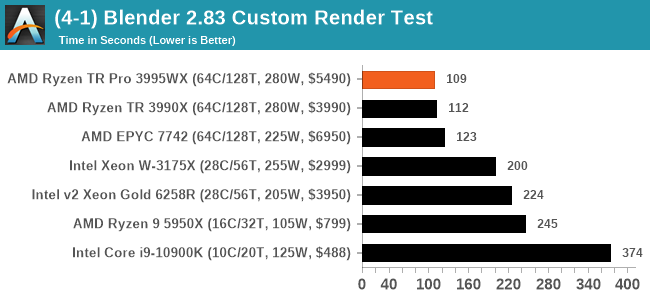
The first benchmark out of the gate and a win is scored by the TR Pro. It's only a small win at around 3%, but it showcases that the eight memory channels outweigh the extra frequency of regular Threadripper here.
Corona 1.3: Link
Corona is billed as a popular high-performance photorealistic rendering engine for 3ds Max, with development for Cinema 4D support as well. In order to promote the software, the developers produced a downloadable benchmark on the 1.3 version of the software, with a ray-traced scene involving a military vehicle and a lot of foliage. The software does multiple passes, calculating the scene, geometry, preconditioning and rendering, with performance measured in the time to finish the benchmark (the official metric used on their website) or in rays per second (the metric we use to offer a more linear scale).
The standard benchmark provided by Corona is interface driven: the scene is calculated and displayed in front of the user, with the ability to upload the result to their online database. We got in contact with the developers, who provided us with a non-interface version that allowed for command-line entry and retrieval of the results very easily. We loop around the benchmark five times, waiting 60 seconds between each, and taking an overall average. The time to run this benchmark can be around 10 minutes on a Core i9, up to over an hour on a quad-core 2014 AMD processor or dual-core Pentium.

Another small 3% win in Corona, and almost double what Intel is offering.
Crysis CPU-Only Gameplay
One of the most oft used memes in computer gaming is ‘Can It Run Crysis?’. The original 2007 game, built in the Crytek engine by Crytek, was heralded as a computationally complex title for the hardware at the time and several years after, suggesting that a user needed graphics hardware from the future in order to run it. Fast forward over a decade, and the game runs fairly easily on modern GPUs.
But can we also apply the same concept to pure CPU rendering? Can a CPU, on its own, render Crysis? Since 64 core processors entered the market, one can dream. So we built a benchmark to see whether the hardware can.
For this test, we’re running Crysis’ own GPU benchmark, but in CPU render mode. This is a 2000 frame test, with medium and low settings.
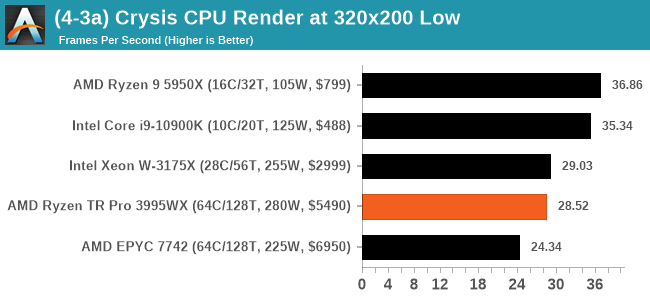
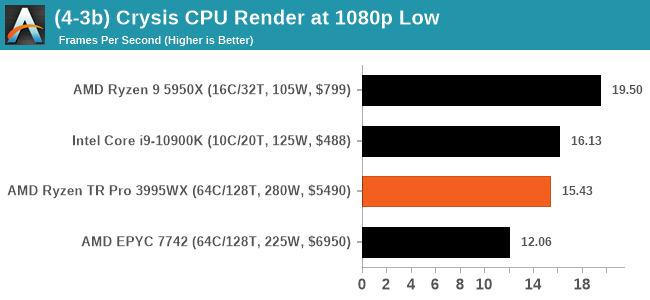
The Crytek engine used for Crysis has two key limitations: up to 32 threads, and up to 23 cores. As a result our high-end CPUs here are pegged to those cores, and single-thread limits come into play. The TR 3995WX has a healthy lead over the EPYC 7742, but loses out against the mainstream processors.
POV-Ray 3.7.1: Link
A long time benchmark staple, POV-Ray is another rendering program that is well known to load up every single thread in a system, regardless of cache and memory levels. After a long period of POV-Ray 3.7 being the latest official release, when AMD launched Ryzen the POV-Ray codebase suddenly saw a range of activity from both AMD and Intel, knowing that the software (with the built-in benchmark) would be an optimization tool for the hardware.
We had to stick a flag in the sand when it came to selecting the version that was fair to both AMD and Intel, and still relevant to end-users. Version 3.7.1 fixes a significant bug in the early 2017 code that was advised against in both Intel and AMD manuals regarding to write-after-read, leading to a nice performance boost.
The benchmark can take over 20 minutes on a slow system with few cores, or around a minute or two on a fast system, or seconds with a dual high-core count EPYC. Because POV-Ray draws a large amount of power and current, it is important to make sure the cooling is sufficient here and the system stays in its high-power state. Using a motherboard with a poor power-delivery and low airflow could create an issue that won’t be obvious in some CPU positioning if the power limit only causes a 100 MHz drop as it changes P-states.
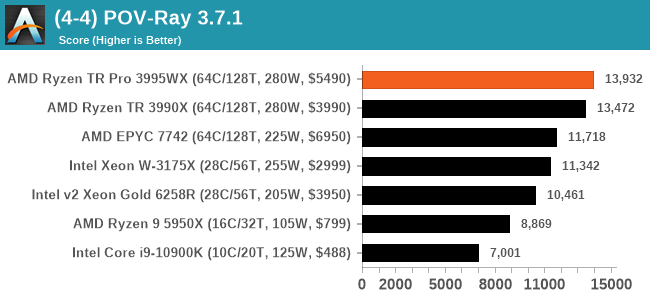
POV-Ray is another 3% win for the TR Pro 3995WX.
V-Ray: Link
We have a couple of renderers and ray tracers in our suite already, however V-Ray’s benchmark came through for a requested benchmark enough for us to roll it into our suite. Built by ChaosGroup, V-Ray is a 3D rendering package compatible with a number of popular commercial imaging applications, such as 3ds Max, Maya, Undreal, Cinema 4D, and Blender.
We run the standard standalone benchmark application, but in an automated fashion to pull out the result in the form of kilosamples/second. We run the test six times and take an average of the valid results.
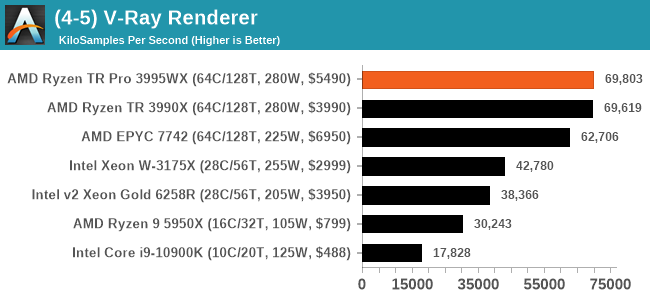
Less than 0.3% win here this time, but AMD's 64-core offerings are still ahead of the game.
Cinebench R20: Link
Another common stable of a benchmark suite is Cinebench. Based on Cinema4D, Cinebench is a purpose built benchmark machine that renders a scene with both single and multi-threaded options. The scene is identical in both cases. The R20 version means that it targets Cinema 4D R20, a slightly older version of the software which is currently on version R21. Cinebench R20 was launched given that the R15 version had been out a long time, and despite the difference between the benchmark and the latest version of the software on which it is based, Cinebench results are often quoted a lot in marketing materials.
Results for Cinebench R20 are not comparable to R15 or older, because both the scene being used is different, but also the updates in the code bath. The results are output as a score from the software, which is directly proportional to the time taken. Using the benchmark flags for single CPU and multi-CPU workloads, we run the software from the command line which opens the test, runs it, and dumps the result into the console which is redirected to a text file. The test is repeated for a minimum of 10 minutes for both ST and MT, and then the runs averaged.
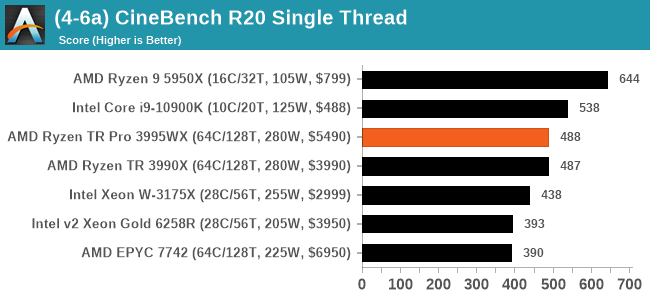
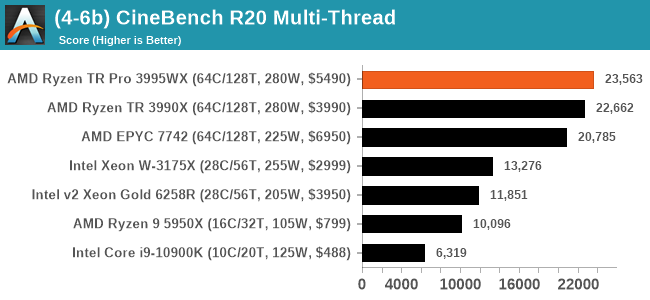
Cinebench ST scores are clearly in the realm of the mainstream processors, but when firing up all the threads, the TR Pro 3995WX takes a 4% lead over the standard 3990X, and scores 2.33x more than the mainstream 16-core Ryzen 9.
















118 Comments
View All Comments
Fellovv - Tuesday, February 9, 2021 - link
Agreed— picked up a p620 with 16c for $2500, could have gotten it for lower from Lenovo if they didn’t have weeks of lead time. Ian- you may see Lenovo discounts all the crazy prices about 50% all year, and sometimes there are Honey coupons to knock off hundreds more.I have read that the 16c 2 CCX 3955WX May only get 4 channel RAM, not the full 8. I may be able to confirm in the near future. Gracias for the fine and thorough review. My only request is to ensure the TR 3990 is included in every graph— it was MIA or AWOL in several. I went with they TR Pro for the RAM and PCIe 4 lanes. Seeing the results confirms it was a good choice for me. Can’t wait for the Zen3!
realbabilu - Tuesday, February 9, 2021 - link
Nice 👍 about mkl, how about blis and open las,.did it suffer high multi core problemMonkeyMan73 - Wednesday, February 10, 2021 - link
AMD has the performance crown in most scenarios, but it comes at an extremely high price point. Might not be worth this kind of money even for most extreme power user. Maybe get a dual core Xeon? Might be cheaper.BTW, your las pic of this review is definitly not an OPPO Reno 2 :)
MonkeyMan73 - Wednesday, February 10, 2021 - link
Apologies, not a Dual core Xeon, that will not cut it but meant a Dual Socket Xeon setup.Oxford Guy - Wednesday, February 10, 2021 - link
The worst aspect of the price-to-performance is that it’s using outdated tech rather than Zen 3.MonkeyMan73 - Sunday, February 28, 2021 - link
Correct, there is always some sort of trade-off.Greg13 - Wednesday, February 10, 2021 - link
I feel like you guys really need to get some more memory intensive workloads to test. So often in these Threadripper / Threadripper Pro / EPYC reviews, the consumer CPU (5950X in this case) is often faster or not far behind even on highly multithreaded applications. I do some pretty large thermal fluid system simulations in Simscape where by once a system is designed I use an optimisation algorithm to find the optimal operating parameters of the system. This involves running multiple simulations of the same model in parallel using Matlab Parallel computing toolbox along with their global optimisation toolbox. Last year I bought a 3950X and 128GB ram to do this, but as far as I can tell it is massivly memory bandwidth limited. It's also memory capacity limited too... Each simulation uses around 10GB ram each, so I generally only run 12 parallel workers to keep within the 128GB of ram. However, In terms of throughput I see barely any change when dropping down to 8 parallel workers, suggesting, I think that with 12 workers, it's massivly memory bandwidth limited. This also seems to be the case in terms of the CPU power, even with 12 workers going, the CPU power reported is pretty low, which leads me to think it's waiting for data from memory?I assume that this would be better with Threadripper or even better with Threadripper Pro with their double and quadrouple memory bandwidth. However I don't have the funds to buy a selection of kit and test it to see if the extra cost is worth it. It would be good if you guys could add some more memory intensive tests to the suite (ideally for me some parallel Simscape simulations!) to show the benefit these extra memory channels (and capacity) offer.
Shmee - Wednesday, February 10, 2021 - link
Yeah I would wait for Zen 3 TR for sure. That said, this would only make sense as X570 has limited IO. It would be great to have a nice 16 core TR that had great OC capability and ST performance, was great in games, and did not have the IO limitation as X570. I really don't need all the cores, mainly I care about gaming, but the current gaming platforms just don't have the SATA and m.2 ports I would like. Extra memory bandwidth is also nice.eastcoast_pete - Wednesday, February 10, 2021 - link
Thanks Ian! I really wanted one, until I saw the system price (: But, for what these proTRs can do, a price many are willing and able to pay.Also, as it almost always comes up in discussions of AMD vs Intel workstation processors: could you write a backgrounder on what AVX is/is used for, and how open or open source extensions like AVX512 really are? My understanding is that much of this is proprietary to Intel, but are those AVX512 extensions available to AMD, or do they have to engineer around it?
kgardas - Wednesday, February 10, 2021 - link
avx512 is instruction set implemented and invented by Intel. Currently available in TigerLake laptops and Xeon W desktops plus of course server Xeons. Previous generation was AVX2 and generation before AVX. AVX comes with Intel's SandyBridge cores 9 years ago IIRC. AVX2 with Haswell.Due to various reasons IIRC AMD and Intel cross-licensed their instruction sets years ago. Intel needed AMD's AMD64 to compete. Not sure if the part of the deal is also future extensions, but I would guess so since AMD since that time implemented both AVX and AVX2. Currently AMD sees no big pressure from Intel hence I guess is not enough motivated to implement avx512. Once it is, I guess we will see AMD chips with avx512 too.